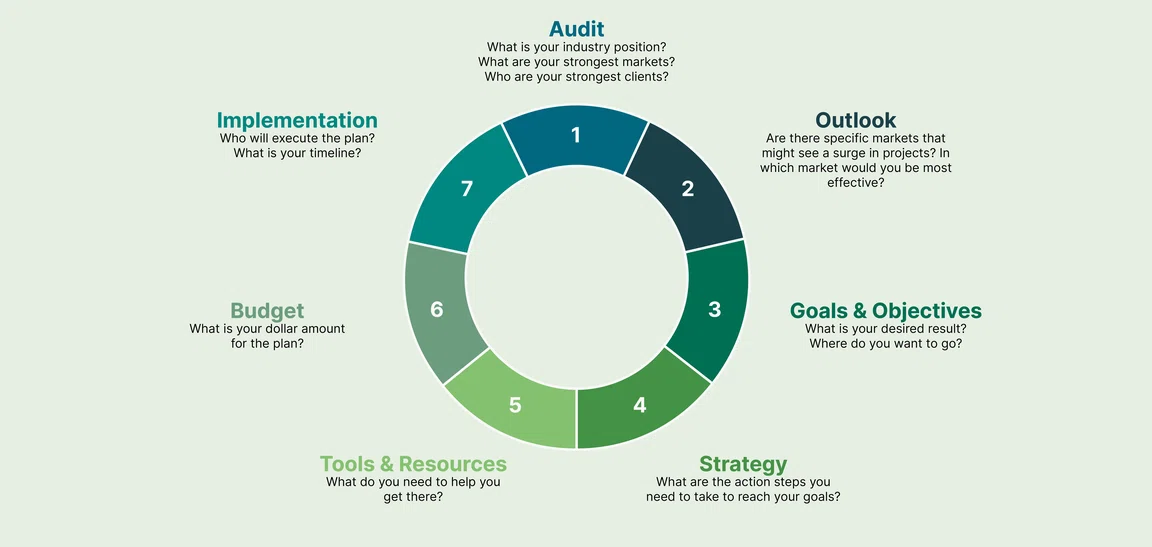newsletter
Sign up for the Marketer QuickLook Newsletter
SMPS Headquarters
625 North Washington Street
Suite 302
Alexandria, VA
22314-1936
email
info@smps.org
phone
703.549.6117



marketing
Marketing Planning Through a Subconsultant Lens

By Krystle English, CPSM, PCM, CF APMP
domain

Amarketing plan is meant to be a road map to your firm’s destination. It includes goals and strategies to ensure you move in the right direction and how to best allocate your budget and resources. When I started in the A/E/C industries, I wasn’t aware of my firm’s marketing plan. In fact, I didn’t even know if we had one. Over the years, as I developed my career, I noticed that a subconsultant’s marketing plan is often different than that of a prime firm. The following steps are a breakdown how we get there, but from a subconsultant perspective.
The seven steps of a subconsultant marketing plan
The seven steps of a subconsultant marketing plan
The SMPS Domains of Practice reference the seven steps of a marketing plan. Here’s how they help guide strategy sessions to create a road map for a subconsultant firm:

During the audit step, determine where you are in the market and where your skill set shines. For any firm, this starts with clients. For a prime firm, the focus is likely on owner clients within target markets. For subconsultants, the focus shifts to the prime clients they team with.
Managing Client Relationships
Managing Client Relationships
There are three approaches to consider when developing client focus:
Target Clients. We develop relationships with clients so that when they identify a project pursuit, they immediately turn to us. First, we inventory our current clients and then identify potential clients. More importantly, we decide if there are clients we no longer want to work with.
Target Markets. We then examine within which markets the clients for whom we’ve had high success rates operate. We also determine if there is potential to team with a new client that has a strong foothold in that market.
Target Relationships. We identify people who can connect us to these key clients and markets. It could be people within our own organization, a design-build partner, or another sub consultant we team with often.
Once we’ve distinguished which clients and markets to focus on, it’s time to convey our unique value proposition. The reason why our firm has been selected to do the work.
Presenting a Unique Value Proposition
Presenting a Unique Value Proposition
A unique value proposition is what sets your firm apart from others. What about you is unlike any other service provider or product? This question is even more crucial for subconsultants—it is the reason a client chooses to team with us over our competitors. When paired with quality work and a healthy relationship, our unique value proposition makes us a trusted adviser to our clients. As a subconsultant, you have specific expertise, but what are the other distinct abilities or characteristics that give your firm that extra edge? Maybe it’s your sustainability efforts or your DEI initiatives. Perhaps it’s niche-specific to the region in which you work.
This is where we review the market research done prior to the strategy meeting. Do you have Freedom of Information Act (FOIA) requests from previous bids that would help clarify how you differ from other firms? Have you participated in debriefs with prime clients to understand the reasons for winning or losing projects? On the lost projects, do you know who won the work and why? Have you surveyed your clients to determine why they like working with you or what you offer, or how you deliver on their goals?
Assessing this information helps craft our unique value proposition. This is what distinguishes your firm and conveys your ability to provide what competitors cannot. Firms must know exactly who they are to successfully pursue and win potential clients.
Becoming a Preferred Consultant
Becoming a Preferred Consultant
As a subconsultant our goal is to become our clients’ preferred consultant. We ask ourselves questions such as “How can we strengthen our position with them? What can we do to become their go-to firm? Do they currently have a preferred consultant and, if so, what is their unique value proposition? Is there an area of weakness in their existing consultant? How can we leverage this information to showcase our firm’s unique abilities?
Executing the Plan
Executing the Plan
Each of the efforts we just discussed can be the focus of planning and strategy sessions. Once we complete the research and brainstorming, we determine how to put our strategy into action. There are many opportunities to grow. Here are a few to consider.
Marketing planning is an important step toward helping your business grow, regardless of your status as a subconsultant or prime. Having a road map with an agenda will lead you in the right direction, enabling you to focus on excellence and earning the designation of preferred consultant. Here’s to your future!
Share:
Krystle English is a marketing director at KPFF Consulting Engineers, where she oversees and directs marketing and business development for the Los Angeles civil engineering office. With more than 17 years of experience in the A/E/C industries, Krystle has a passion for helping others find their creative potential and tell stories through great design and architecture. She is a Certified Professional Services Marketer (CPSM), Professional Certified Marketer (PCM), has APMP Foundation-Level Certification (CF APMP), and an MBA from Keller Graduate School of Management.
Connect with Krystle on
READ NEXT














